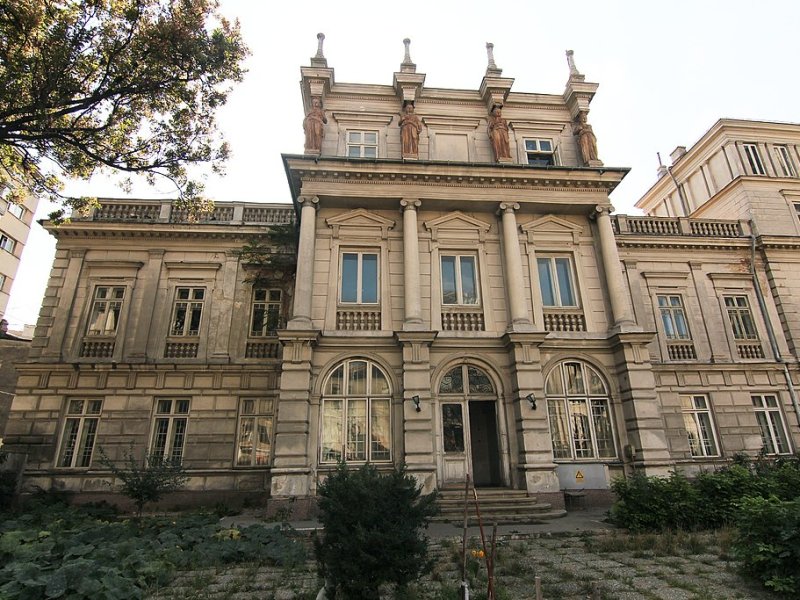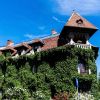Stirbei Palace in Bucharest. From the host of the most lavish balls to a project for a luxury mall

By Bucharest Team
- Articles
The Stirbei Palace in Bucharest, located on Calea Victoriei, is, together with the Stirbei Palace in Buftea, one of the most emblematic architectural monuments in the Romanian capital. Two locations, two palaces of an ancient family of Romanian rulers, with the same beginning of the story. Twenty kilometers separate them and only a few years apart.
If we have written about the Stirbei Palace in Buftea, now it is time to pay due attention to the palace of the same name, on Calea Victoriei.
The history of the Stirbei Palace in Bucharest began between 1833 and 1835. In 1849, after Prince Barbu Stirbei was proclaimed Prince of Romania, the construction of the central body of the Palace (which later served as the Princely Palace) began, according to the plans of architect Michel Sanjouand.
Designed by the architect Joseph Hartl, the palace combines Neoclassical and Renaissance architectural styles, reflecting the refined tastes of the Romanian elite of the time. The facade of the building is ornamented with elaborate sculptural details and the interior is enriched by lavish chandeliers, period furniture and richly decorated stuccowork.
Twenty years later, the Stirbei Palace became the property of the sons of Lord Barbu Stirbei. This was followed by a period of its development, so that the stables and annexes appeared, which later acquired other purposes - such as the "Știrbei" shop, where wine and canned food produced at the "Știrbei" canning factory in Buftea were sold. The palace underwent further alterations when the owner was Prince Alexandru Stirbei.
On the ground floor of the palace were the ballroom, two other parlors, a library and a chapel. Upstairs were a parlor, another library, the former bedroom of Stirbei Voda, the former throne room, an office, bedrooms, children's rooms. The servants' rooms were in the attic. During the inter-war period, the Palace was the venue for social events, galas, operetta performances, classical music recitals, weddings, and large parties.
During World War II, the building was used by various organizations and suffered significant damage.
After the communist regime, the palace was nationalized and used for various administrative purposes. In the fateful year of 1948, the Stirbei family's properties were confiscated by the state, partially and then entirely. Six years later, the residence became the seat of the Museum of Popular Art, and in 1980, the Stirbei Palace became under the administration of the Art Museum of the Socialist Republic of Romania, housing in its rooms collections of ceramics and glass - collections with which it became so closely identified that two years later, the palace became the Museum of Ceramics and Glass, a function it held until 1990.
Between 1994 and 2004, the palace was in the process of being returned to the descendants of the Stirbei family, being abandoned. The state did not exercise its pre-emptive right to purchase the building because it lacked the necessary funds.
Unfortunately, the inheritance of three generations of the Stirbei family ended up - in 2005 - in the ownership of a certain businessman, Ovidiu Popescu, (together with annexes and the vacant land behind and even with the "litigious rights" over a large area of land stretching along Calea Victoriei, Banului Street, G-ral Budișteanu Street and Calea Griviței), for the sum of 11 million euro. The new owner quickly proposes a real estate project on the land behind the palace, where he wanted to build a shopping mall. At the same time he obtained from the Ministry of Culture the downlisting of the former Administration of the Stirbey Domains from the List of Class A Historical Monuments so that the building could be demolished, which unfortunately happened. Subsequently, in April 2009, the construction of a 40-meter tower block next to the Stirbey Palace was also approved. According to the project, the new building is right next to the palace, and would have had a hotel, housing and more than 5,000 square meters of commercial space.
After a whole ping-pong process between the state institutions and the businessman, the building permit for the tower block is no longer being issued because the project does not comply with all the legal conditions and affects the built heritage. Ovidiu Popescu is claiming damages of around €6 million from the Ministry of Culture, which claims it does not have the material resources to consolidate the palace alone, without doing the project behind it. In reply, the Minister of Culture says he is doing his best to protect the built heritage.
In 2011, the property is taken over by the son, Alexandru Popescu, after the father's death, who makes no further investments, initially blocked by the DNA investigation and later probably by the lack of capital.
And in the following years, the Stirbey Palace was the subject of the same controversies over renovation projects and use. Modernization plans had to balance the need for heritage conservation with modern requirements of functionality and safety. Some real estate development projects near the palace have sparked public debate about the impact on the historic area and the building itself.
Between 2018 and 2019, Israeli firm Hagag also announced the acquisition of the Stirbey property from Alexandru Popescu for around €10 million, with the desire to turn the space into a luxury mall.
Fortunately, the mall project - planned to be erected in the palace courtyard - also fell through after years of protests from civil society and NGOs.
In November 2023, Hagag Development Europe announces and begins the restoration of the Stirbei Palace. The Mayor General of the Capital, Nicușor Dan, announced as early as 2022 that he had signed the authorization for its restoration.
"The private owner of the building will renovate it at his own expense, preserving all the architectural elements and rebuilding the missing body of the former carriage shed. This is the first time since 1989 that a heritage building that was demolished will be rebuilt. I would like to point out that no other modern construction will be allowed that would affect the palace and the adjacent area from an urban planning point of view," said Mayor Nicușor Dan.
Over the decades, the Stirbei Palace has played a significant role in the social and political life of Romania, and today it is a symbol of Bucharest's cultural heritage. We hope that its value will be appreciated and that we and our descendants will be able to enjoy its imposing architecture and rich history for a long time to come.






























